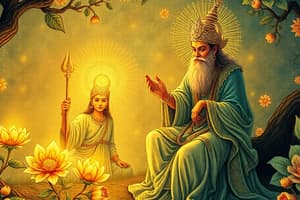Podcast
Questions and Answers
What was the primary focus of the Alvars in their devotion?
What was the primary focus of the Alvars in their devotion?
- Creating large temples for worship
- Worship of abstract forms of gods
- Reform of the caste system
- Devotion to anthropomorphic forms of Vishnu (correct)
Which of the following statements about the Nayanars is true?
Which of the following statements about the Nayanars is true?
- They were solely responsible for constructing temples.
- Their hymns were sung in Sanskrit.
- They were leaders and devotees of Shiva. (correct)
- They exclusively celebrated abstract forms of divinity.
How did the compositions of the Alvars and Nayanars compare to the Vedas?
How did the compositions of the Alvars and Nayanars compare to the Vedas?
- They represented a shift away from Brahmanical traditions.
- Their compositions were sometimes regarded as equally important. (correct)
- They initiated the exploration of Buddhist teachings.
- They were considered less significant.
What societal issue did the Alvars and Nayanars address through their practices?
What societal issue did the Alvars and Nayanars address through their practices?
What was a common background among the followers of the Alvars and Nayanars?
What was a common background among the followers of the Alvars and Nayanars?
What motivated Akbar to visit the shrine of Shaikh Nizamuddin Auliya multiple times?
What motivated Akbar to visit the shrine of Shaikh Nizamuddin Auliya multiple times?
Which Sultan first visited the shrine of Shaikh Nizamuddin Auliya?
Which Sultan first visited the shrine of Shaikh Nizamuddin Auliya?
What notable contribution did Akbar make during his visits to the shrine of Shaikh Nizamuddin Auliya?
What notable contribution did Akbar make during his visits to the shrine of Shaikh Nizamuddin Auliya?
Which of the following statements is true concerning the shrine of Shaikh Nizamuddin Auliya during the sixteenth century?
Which of the following statements is true concerning the shrine of Shaikh Nizamuddin Auliya during the sixteenth century?
What was the purpose of the mosque constructed within the compound of Shaikh Nizamuddin Auliya's dargah by Akbar?
What was the purpose of the mosque constructed within the compound of Shaikh Nizamuddin Auliya's dargah by Akbar?
Flashcards are hidden until you start studying
Study Notes
The Bhakti Movement
- Worship centered around specific deities like Shiva and Vishnu in anthropomorphic forms; Nirguna bhakti represents an abstract divine.
- Alvars (devotees of Vishnu) and Nayanars (devotees of Shiva) emerged in Tamil Nadu around the sixth century as pioneers of bhakti movements.
- These poet-saints inspired travel and performed devotional hymns in Tamil, spreading their religious messages and identifying sacred shrines.
Influence on Caste System
- Alvars and Nayanars challenged the caste hierarchy, promoting inclusivity among followers from diverse social backgrounds, including outcastes and artisans.
- Their compositions gained esteem, likened by some to the revered status of the Vedas, reflecting their influence in religious practices.
Mughal Interaction with Sufism
- Mughal emperors, particularly Akbar, formed connections with Sufi shrines, evidenced by repeated pilgrimages to the Ajmer tomb of a renowned Sufi saint, leading to support and infrastructure for these pilgrimage sites.
- Jahanara, Akbar’s daughter, embodies the integration of Mughal authority with Sufi practices, exemplifying strong ties between royal patronage and spiritual leadership.
Kabir's Doctrines
- Kabir, a significant figure of the 14th-15th centuries, contributed profound poetical insights questioning religious divisions, promoting the idea of one universal God called by many names.
- His verses, preserved in various texts like the Kabir Bijak and incorporated into Sikh scriptures, stress the futility of sectarian distinctions and emphasize divine unity.
Guru Nanak and Sikhism
- Guru Nanak, founder of Sikhism, promoted communal worship through collective recitations, establishing rules that guide the faith.
- After his passing, the consolidation of Sikh practices emerged, leading to the creation of the Adi Granth Sahib, which includes hymns from several spiritual poets.
- Guru Gobind Singh, the tenth guru, established the Khalsa Panth, formalizing the distinctive identity of the Sikh community with significant symbols.
Mirabai's Devotional Legacy
- Mirabai, a notable female poet from the bhakti tradition, expressed her devotion through bhajans and became a pivotal figure representing the spiritual aspirations of women within the movement.
- Her life stories and teachings were reconstructed from the oral transmission of her poems, highlighting her enduring influence across generations.
Studying That Suits You
Use AI to generate personalized quizzes and flashcards to suit your learning preferences.




